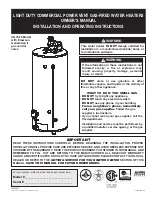
11
10
Vent Termination through-the-Wall
PVC AND CPVC VENT SYSTEM:
PolyPro
®
InnoFlue
®
A 45-degree PVC elbow is supplied with the water
heater and shall be used as the termination elbow for
through-the-wall installation when the vent system is
built with PVC pipes (
see Figure 8
). If CPVC is used
to build the vent system, use a 45-degree CPVC elbow
that is approved to be used with the vent system. A
wire mesh must be installed in the termination elbow.
POLYPROPYLENE SYSTEM:
PolyPro
®
InnoFlue
®
PolyPro
®
InnoFlue
®
A 45-degree polypropylene elbow approved to be
used with the vent system shall be used as the termi-
nation elbow for through-the-wall installation. Be sure
to remove the wire mesh screen that was supplied
with the 45-degree PVC elbow and insert it in the
polypropylene elbow. Push the screen until it locks in
place inside the elbow.
Vent Termination through-the-Roof
PVC AND CPVC VENT SYSTEM:
PolyPro
®
InnoFlue
®
A 90-degree elbow (not supplied) shall be used as
the termination elbow for Through-the-Roof installa-
tion (
see Figure 8
). Use a 90-degree elbow that is
made of the same material as the vent system and
approved to be used with this vent system. Be sure
to remove the wire mesh screen that was supplied
with the 45-degree PVC elbow and insert it into the
90-degree elbow. Push the screen until it locks in
place inside the elbow.
POLYPROPYLENE SYSTEM:
PolyPro
®
InnoFlue
®
PolyPro
®
InnoFlue
®
A 90-degree polypropylene elbow, approved to be
used with the vent system shall be used as the termi-
nation elbow for through-the-roof installation. Be sure
to remove the wire mesh screen that was supplied
with the 45-degree PVC elbow and insert it into the
polypropylene elbow. Push the screen until it locks in
place inside the elbow.
DANGER
WARNING
CAUTION
AVERTISSEMENT
ATTENTION
When the installation is complete, visually inspect
the venting system to make sure that all joints are
properly connected and all instructions have been
followed. Failure to properly install the venting sys-
tem could result in property damage, personal inju-
ry, or death.
Condensation in the Venting System
In order to effectively control the condensate from
adversely affecting the mechanical components of the
water heater (draining back into the blower), a rubber
adaptor with a drain outlet is mounted directly on the
blower vent outlet. A plastic tube can be attached to
this outlet to drain any condensate that has accumu-
lated, away from the water heater. Make sure that the
condensate removal tube flows to a suitable free-flow-
ing drain.
Water Piping
Refer to
Figure 11
for a typical installation. Use of
this layout should provide a trouble-free installation
for the life of the water heater. Before making the
plumbing connections, locate the
COLD
water inlet
and the
HOT
water outlet. These fittings are both
3
/
4
”
N.P.T. male thread. Make sure that the dip-tube is
installed in the cold water inlet. Install a shut-off valve
close to the water heater in the cold water line. It is
recommended that unions be installed in the cold and
hot water lines so that the water heater can be easily
disconnected, if servicing is required.
When assembling the hot and cold piping, use a
good food grade of pipe joint compound, and ensure
all fittings are tight. It is imperative that open flame is
not applied to the inlet and outlet fittings, as heat will
damage or destroy the plastic-lined fittings. This will
result in premature failure of the fittings, which is
not covered by the warranty.
Temperature and Pressure-Relief Valve
To protect from excessive pressure and/or tempera-
ture, the manufacturer has installed a temperature and
pressure-relief valve that meets the requirements of
the Standard for Relief Valves and Automatic Gas
Shut-Off Devices for Hot Water Supply Systems,
CSA 4.4, in Canada, and ANSI Z21.22, in the United
States. This relief valve has a maximum set pressure
that does not exceed the hydrostatic working pres-
sure of the water heater (150 psi = 1,034 kPa) and a
BTU/hr rating equal to or greater than the input rating,
as shown on the water heater rating plate. It should
never be plugged or removed from the opening marked
for it on the water heater.
DO NOT
plug the temperature and pressure-relief
valve or its discharge line.
DO NOT
remove the relief
valve. Make sure the relief valve is properly sized for the
water heater. If the relief valve continuously
discharges water, call a qualified service technician to
correct the problem. Failure to follow these instructions
can result in property damage, personal injury, or death.
DANGER
WARNING
CAUTION
AVERTISSEMENT
ATTENTION
If this relief valve should need to be replaced, use only
a new temperature and pressure-relief valve. Never
install an old or existing relief valve, as it may be dam-
aged or inadequate for the working requirements of
INSTALLATION INSTRUCTIONS











































